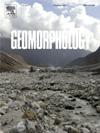Scale-dependent interactions in coastal biogeomorphic landscapes: Pioneer both inhibits and facilitates primary foredune builder across spatial scales
IF 3.1
2区 地球科学
Q2 GEOGRAPHY, PHYSICAL
引用次数: 0
Abstract
Ecosystem engineers often drive landscape formation and vegetation succession by modifying environmental conditions. Along the Northwestern European coast, dune formation is classically believed to be pioneered by sand couch (Elytrigia juncea), followed by the primary foredune builder marram grass (Calamagrostis arenaria, formerly Ammophila arenaria) once sufficiently large dunes have formed. However, these ideas lack experimental validation, leaving the specific relationship between sand couch, the landscape they form, and marram grass establishment unknown. Here, we experimentally investigated this relationship by planting 975 young marram grass plants in two sand couch dominated, embryonic dune systems. Using structural equation models, we examined the effect of sand couch and the landscape attributes (i.e., elevation, distance to sea and elevation change) on marram grass establishment. Results reveal indirect local inhibition by sand couch via landscape modifications on survival of establishing marram grass. Specifically, sand couch elevated the environment. In turn, elevated areas eroded (i.e., changed in elevation) more in winter, which was the key factor reducing marram grass survival. At the landscape scale, however, we observed the highest survival in relatively stable and sheltered microsites formed because of sand couch induced dune building. While the indirect local inhibition by sand couch for marram grass survival was found at both locations, the direct effect of sand couch on marram grass survival and shoot formation were location and thus context dependent. For marram grass survival, the relation with sand couch was neutral in exposed and positive in sheltered conditions and for shoot formation it was negative in exposed and neutral in sheltered conditions. Similar to scale-dependent interactions found in other biogeomorphic landscapes (e.g., salt marshes, seagrass, mussel beds), we suggest that interspecific facilitation acts on larger spatial scales rather than the commonly suggested small-scale facilitation through created elevation. More specifically, we suggest that dune formation by pioneer species leads to the creation of stable and sheltered microsites beneficial for establishment of later successional species at the landscape-scale.
沿海生物地貌景观中规模依赖性的相互作用:先锋在不同空间尺度上既抑制又促进原生前沙丘的形成
生态系统工程师通常通过改变环境条件来推动地貌形成和植被演替。在欧洲西北部沿海地区,人们通常认为沙丘是由沙榻(Elytrigia juncea)率先形成的,一旦形成足够大的沙丘,沙丘前的主要植被马兰草(Calamagrostis arenaria,原名 Ammophila arenaria)就会随之形成。然而,这些观点缺乏实验验证,因此沙榻、沙榻形成的地貌和金缕梅草形成之间的具体关系尚不清楚。在这里,我们在两个以沙榻为主的胚胎沙丘系统中种植了 975 株幼小的马兰草,对这种关系进行了实验研究。利用结构方程模型,我们研究了沙垫和景观属性(即海拔、距海距离和海拔变化)对马兰草生长的影响。结果表明,沙榻通过地貌改变间接抑制了金盏菊的成活。具体来说,沙榻抬高了环境。反过来,高地在冬季受到的侵蚀(即海拔高度变化)更大,这是降低马蔺存活率的关键因素。然而,在地貌尺度上,我们观察到,由于沙榻引起的沙丘形成,在相对稳定和遮蔽的微观环境中,马蔺的存活率最高。虽然在这两个地点都发现了沙垫对金盏菊存活率的间接局部抑制作用,但沙垫对金盏菊存活率和新芽形成的直接影响是因地制宜的。就马蔺的存活率而言,沙垫与马蔺存活率的关系在暴露条件下为中性,在遮蔽条件下为阳性;就新芽形成而言,沙垫与新芽形成的关系在暴露条件下为负性,在遮蔽条件下为中性。与在其他生物地貌景观(如盐沼、海草、贻贝床)中发现的规模依赖性相互作用类似,我们认为种间促进作用是在更大的空间尺度上发生的,而不是通常所说的通过所创造的海拔高度进行小规模的促进作用。更具体地说,我们认为先驱物种形成的沙丘会创造出稳定和遮蔽的微生境,有利于后继物种在景观尺度上的建立。
本文章由计算机程序翻译,如有差异,请以英文原文为准。
求助全文
约1分钟内获得全文
求助全文
来源期刊

Geomorphology
地学-地球科学综合
CiteScore
8.00
自引率
10.30%
发文量
309
审稿时长
3.4 months
期刊介绍:
Our journal''s scope includes geomorphic themes of: tectonics and regional structure; glacial processes and landforms; fluvial sequences, Quaternary environmental change and dating; fluvial processes and landforms; mass movement, slopes and periglacial processes; hillslopes and soil erosion; weathering, karst and soils; aeolian processes and landforms, coastal dunes and arid environments; coastal and marine processes, estuaries and lakes; modelling, theoretical and quantitative geomorphology; DEM, GIS and remote sensing methods and applications; hazards, applied and planetary geomorphology; and volcanics.
 求助内容:
求助内容: 应助结果提醒方式:
应助结果提醒方式:


